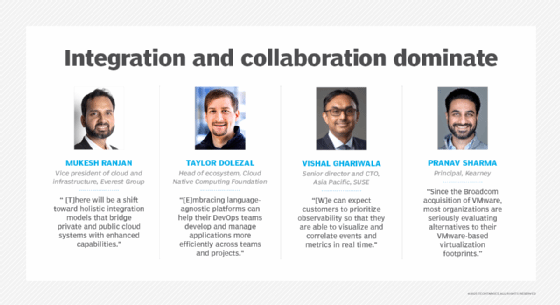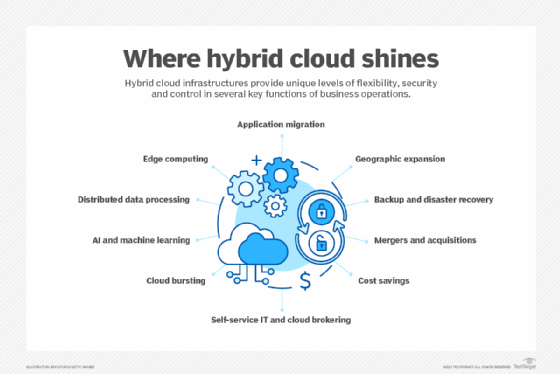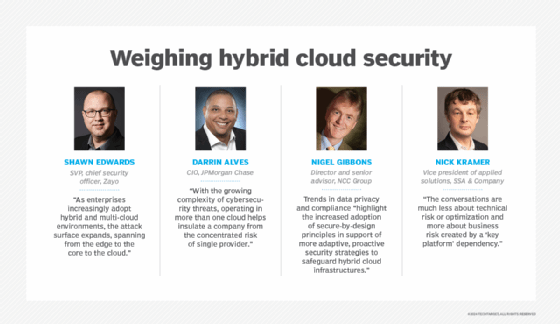The future of hybrid cloud: What to expect in 2025 and beyond
For companies modernizing their business operations, hybrid cloud's embrace of AI, edge computing and integration promises unique levels of flexibility, security and control.
Hybrid cloud infrastructure is evolving rapidly. Businesses are exploring how the new platforms can improve disaster recovery, reduce costs and facilitate the rollout of edge computing, while CIOs struggle with the workload modernization costs required to run more applications in the cloud.
Hybrid cloud tools have new control planes that facilitate better management in the cloud and on-premises. Innovations in language-agnostic hybrid cloud tools could further bolster these efforts. CIOs see hybrid cloud's potential to distribute risks and enable AI and machine learning at scale. AI and automation incorporated in hybrid cloud tools support better monitoring, management, governance and security. These and more trends are directly impacting business operations and shaping hybrid cloud's future.
Greater flexibility and control
"A major trend shaping the future of hybrid cloud is the integration of comprehensive control planes into open source projects," said Taylor Dolezal, head of ecosystem at the Cloud Native Computing Foundation, an open source, vendor-neutral hub for cloud-native computing. These new platforms are ideal for building and running cloud-native applications and provide a flexible and secure way to manage cloud resources in various environments. As enterprises prioritize specialized technologies that cater to their IT team's unique engineering needs, these control planes can streamline cloud resource management and save time for developers.
It'll be critical for CIOs to invest in platforms that can balance flexibility and adaptability with control and security. As hybrid cloud environments increase in complexity, enterprises will need to maintain consistent security protocols. They'll also invest in things like infrastructure as code to ensure application updates, data and infrastructure don't become siloed. These investments into true control at the infrastructure level will improve the ability to effectively manage complex hybrid environments.
Expect significant growth of serverless computing and containerization technologies for hybrid cloud, added Nick Kramer, vice president of applied solutions at consultancy SSA & Company. These technologies enable developers to build and deploy applications more efficiently across different cloud and on-premises environments without code and configuration changes. "This will lead to faster development cycles, improved scalability and reduced operational overhead," Kramer said.

Holistic private cloud offerings by hyperscalers
Hyperscalers such as AWS and Azure will likely expand their private cloud offerings beyond data residency applications. "Inspired by competitors like HPE GreenLake and Oracle Cloud@Customer, there will be a shift toward holistic integration models that bridge private and public cloud systems with enhanced capabilities," said Mukesh Ranjan, vice president of cloud and infrastructure at advisory firm Everest Group.
Also, expect some cloud repatriation for certain workloads, especially those that perform better with specialized hardware, predicted Alexander Wurm, senior analyst at advisory firm Nucleus Research. "[T]his repatriation is particularly widespread," he said. Businesses are also becoming more sophisticated in their approach, adopting a 'right workload, right place' strategy that often results in a hybrid infrastructure.
AI and machine learning at scale
Hybrid cloud architectures will fuel the rapid evolution of AI and generative AI (GenAI), surmised Darrin Alves, CIO of global technology infrastructure at JPMorgan Chase & Co. Distributed multi-cloud models enable businesses to meet the data and compute requirements necessary in training AI and machine learning models and roll them out at scale more efficiently. "Having the ability to operate securely in multiple [cloud] providers," Alves explained, "will allow rapid movement as the landscape changes and providers emerge with different models and offerings."
As a result, businesses will increasingly turn to hybrid cloud models as part of their GenAI initiatives. The preference for on-premises compared with cloud GPUs used to power AI workloads will continue to grow, Ranjan said. This trend could create opportunities for AI server manufacturers to support new AI-as-a-service models that offer integrated hardware and managed services to support enterprise AI initiatives.
Language-agnostic, cloud-native apps
There will be greater adoption of language-agnostic, open source platforms to simplify the management of cloud applications, Dolezal predicted. These platforms are gaining popularity because of their ability to support diverse application architectures and provide more flexibility for hybrid cloud strategies. On the engineering side, these capabilities address the challenges of integrating platforms into existing infrastructures, while adopting CI/CD and applying best practices to infrastructure-as-code tooling.
"Whether CIOs are looking to make their operations more efficient, launch and scale new applications, or a mix of both, embracing language-agnostic platforms can help their DevOps teams develop and manage applications more efficiently across teams and projects," Dolezal explained. CIOs will still need to ensure their developer platforms are compatible across cloud services and can handle the complexity of large-scale hybrid cloud deployments.
A common challenge has been difficulty in identifying and remediating issues across infrastructure and applications. "In 2025, we can expect customers to prioritize observability so that they are able to visualize and correlate events and metrics in real time -- from the infrastructure to the application across their hybrid cloud environment," predicted Vishal Ghariwala, senior director and CTO, Asia Pacific, at SUSE.
The hybrid cloud ecosystem will continue grappling with visibility challenges. New products from Broadcom and FinOps providers like CloudHealth Technologies will redefine observability standards. "Service providers integrating these tools into managed services will gain a competitive edge," Ranjan said.

Single-vendor blues
VMware has been a key player in hybrid cloud scenarios, but enterprises are starting to question their reliance on the vendor in the wake of the Broadcom acquisition, which triggered some costs to rise multiple times. "Since the Broadcom acquisition of VMware, most organizations are seriously evaluating alternatives to their VMware-based virtualization footprints," reported Pranav Sharma, principal at consultancy Kearney. Top choices include Nutanix, which supports a wide range of virtualization stacks, including VMware ESXi and Microsoft Hyper-V; Kernel-based Virtual Machine, a Linux-based virtualization with offerings by Oracle, Red Hat and others; and Hyper-V, for customers closely embedded in the Microsoft ecosystem with smaller scale needs.
Along these lines, there seems to be more hybrid-cloud conversations about cost containment and reducing the risk of depending on one vendor, Kramer observed. "The conversations," he added, "are much less about technical risk or optimization and more about business risk created by a 'key platform' dependency."
One upshot has been an explosion in the number of management tools for seamlessly integrating multiple environments via load-balancing, compliance-based optimization and cost considerations. "Even the hyperscalers themselves," Kramer said, "have rolled out services to integrate with and manage various hybrid cloud deployments, including with each other's specialized edge solutions and on-prem environments."
Cloud resilience will be a top priority, Alves said, as CIOs advance their digital transformation initiatives and continue investing in hybrid cloud. "With the growing complexity of cybersecurity threats," he said, "operating in more than one cloud helps insulate a company from the concentrated risk of single provider."
Workload modernization challenges
"The cost of modernizing workloads is a consistent issue for CIOs who recognize the promise of moving to the cloud but lack either the funds, people or knowledge to effectively make the transition," Wurm said. As a result, technology vendors are starting to prioritize a run-anywhere model so businesses can focus on future development in a cloud environment, while maintaining support for existing on-premises workloads. Wurm recommended that CIOs adopt a phased cloud transition strategy, prioritizing cloud-native development to achieve effective and budget-conscious modernization of applications and workloads.
CIOs will increasingly benefit from a customized multivendor environment to meet their goals. Finding the right mix of providers and features can help businesses optimize their investments in the cloud. Using Arm processors in servers rather than the current x86 model, for example, can often reduce costs. "With limited choices for on-premises infrastructure," Alves surmised, "it is easier to do that in the cloud than it is to do it on-prem."
Energy efficiency and sustainability
Hybrid cloud products will increasingly prioritize energy efficiency and sustainability. Cloud providers and businesses will implement green initiatives, such as using renewable energy sources for data centers and optimizing resource usage to reduce carbon footprints. These initiatives will be driven less by social pressure, at least for 2025, and more by the soaring costs incurred by cloud providers and their customers as they experiment and scale AI and GenAI. "This is one case where business and ESG incentives align," Kramer noted.

Data security, privacy and compliance
Businesses are increasingly exploring the use of hybrid cloud and multi-cloud strategies to improve their cybersecurity risk posture. Key trends in security include adopting zero trust architectures to verify all users and devices, integrating AI and machine learning for real-time threat detection and response, and consolidating preventive and detective measures through unified security frameworks like cloud-native application protection platforms, according to Nigel Gibbons, director and senior advisor at cybersecurity consultancy NCC Group.
Businesses are also prioritizing data privacy and compliance to meet increasing regulatory demands and protect sensitive information. "Together, these trends highlight the increased adoption of secure-by-design principles in support of more adaptive, proactive security strategies to safeguard hybrid cloud infrastructures against evolving threats and challenges," Gibbons explained.
Security and data residency have become increasingly important with the expansion of regulatory oversight and cybersecurity risks. "This has prompted a more nuanced conversation about how to effectively balance the benefits delivered by a cloud environment with regulatory complexities and potential risks," Wurm said. Hybrid cloud approaches have emerged as an early remedy, enabling businesses to keep sensitive data on-premises and control data location in line with regulations while maintaining cloud agility.
Expect greater adoption of self-healing networks and automation to autonomously detect and mitigate threats to reduce downtime and enhance resilience, predicted Shawn Edwards, SVP chief security officer at Zayo, an international network services and connectivity provider. "As enterprises increasingly adopt hybrid and multi-cloud environments," he explained, "the attack surface expands, spanning from the edge to the core to the cloud." As result, businesses will need to make security a fundamental part of cloud infrastructure design rather than an afterthought.
George Lawton is a journalist based in London. Over the last 30 years, he has written more than 3,000 stories about computers, communications, knowledge management, business, health and other areas that interest him.







